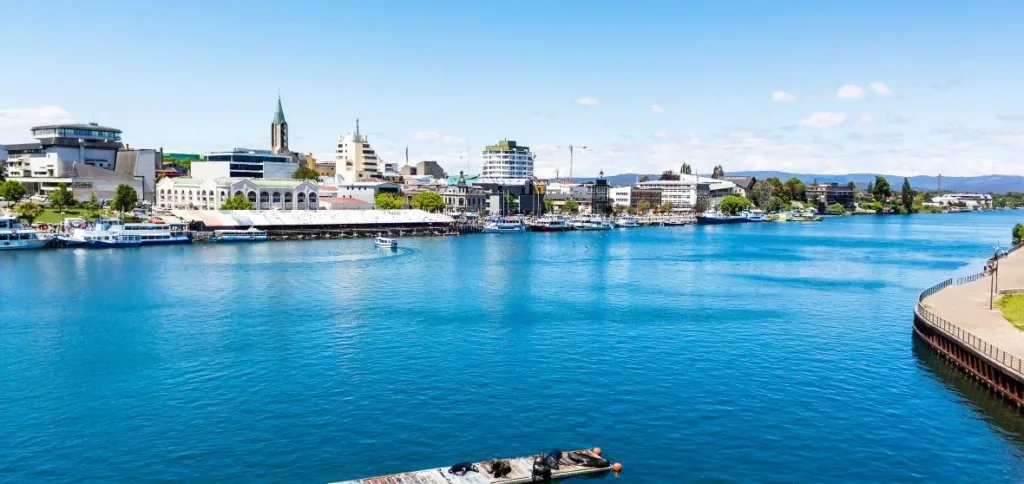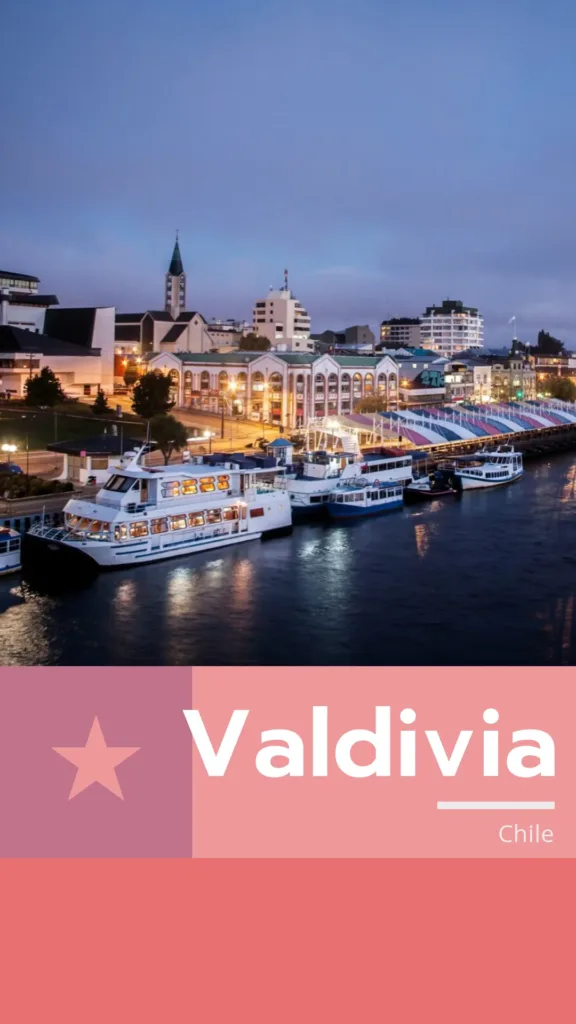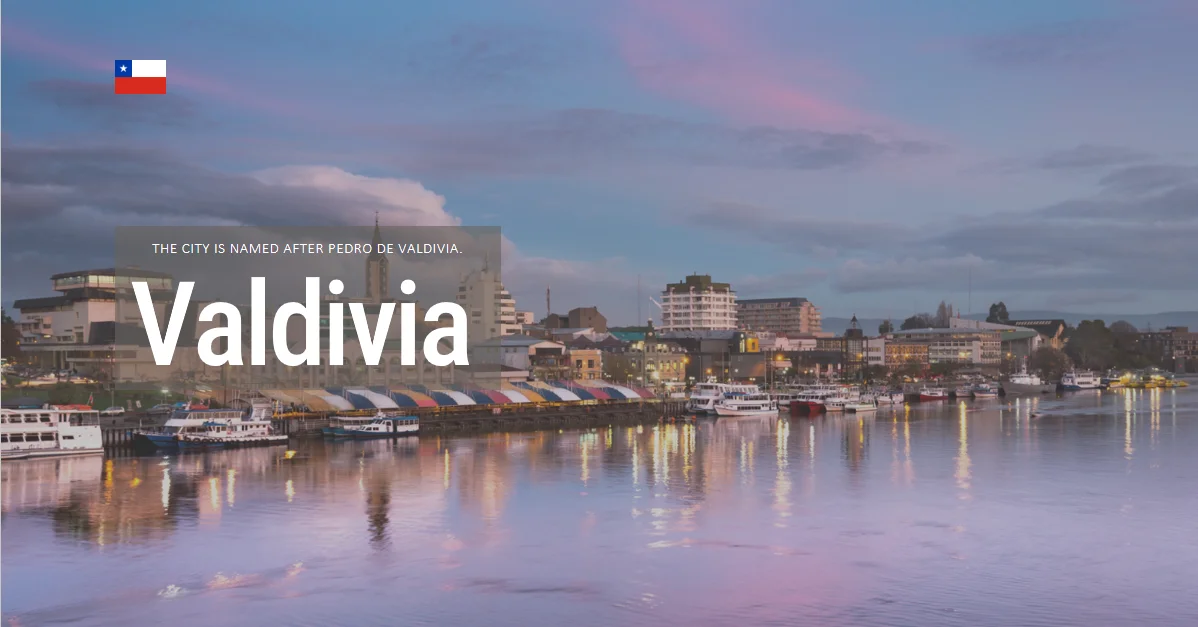Valdivia
Valdivia is the capital city of the Los Ríos Region and Valdivia Province. The city is named after its founder, Pedro de Valdivia.
Valdivia is situated at the junction of the Calle Calle and Cruces rivers, where they converge into the Valdivia River, approximately 11 miles from the Pacific Ocean.
Brief History of Valdivia
The area around Valdivia has a long history of human habitation, with archaeological evidence suggesting occupation since 12,000 – 11,800 BC.
This challenges the conventional “Clovis First” migration theory, proposing that early inhabitants may have reached the Americas by watercraft. During the Middle Archaic period, indigenous groups in southern Chile shared a common lithic culture known as the Chan-Chan Complex, centred around the archaeological site of Chan-Chan.
There was an unrelated Valdivia culture on Ecuador’s coast, thriving between 3500 BCE and 1500 BCE near the village of Valdivia.
These findings contribute to a nuanced understanding of early human settlements in the Valdivia region, revealing diverse cultural developments and migration patterns.
By the time of the Spanish conquistadores, Valdivia was inhabited by the Huilliche, a subgroup of the Mapuche people. The area, known as Ainil, was a significant trade centre with a large village and access to the sea and interior through rivers. Described as a “little Venice” with wetlands and canals, Ainil had a bustling market that received goods from the coast, Punucapa, and San José de la Mariquina.
The modern Feria Fluvial along the Valdivia River is a remnant of this ancient trade. The region had extensive plains with a substantial population engaged in agriculture, cultivating potatoes, maize, quinoa, and legumes. Historical estimates of the population vary, with some suggesting 30 to 40 thousand inhabitants in 1548, while others, like Pedro Mariño de Lobera, claimed half a million Indians within ten leagues of the city. However, some historians argue that these numbers might be exaggerated.
Charles Darwin, in the 19th century, observed limited cleared land near Valdivia, hinting that pre-Hispanic agriculture in the region was more extensive than what he witnessed during his visit in the early 1800s. This historical account reflects the rich and complex pre-colonial history of Valdivia and its indigenous inhabitants.

The Great Chilean earthquake
In 1960, the Great Chilean earthquake, the most potent quake ever documented at magnitude 9.5, inflicted severe damage upon Valdivia. The tremor resulted in approximately 2 meters of subsidence around Valdivia, leading to the permanent flooding of significant expanses of former pastures and cultivated fields. Today, both within the urbanized region of Valdivia and its outskirts, various protected wetlands have been established.
Geography
Situated within the Chilean Patagonia, the Valdivia region showcases a landscape characterized by wetlands and alluvial terraces.
Various rivers, including Cau-Cau, Calle-Calle, and Cruces, converge near the city to form the expansive Valdivia River, flowing into Corral Bay on the Pacific Ocean, just approximately 15 km west of Valdivia, this river network has historically positioned Valdivia as a prominent trade hub, dating back to pre-Hispanic times.
The city originated on a riverine terrace and later expanded into neighbouring wetlands. Valdivia finds itself encompassed by hills on all sides, except the north, where the lowlands connect to the flatlands of San José de la Mariquina.
Certain hilly areas surrounding Valdivia boast diverse vegetation, including exotic forest species like Douglas-fir, Pinus radiata, and Eucalyptus globulus. Some spaces are designated for recreational use or the preservation of native ecosystems. Residential areas commonly feature Northern Hemisphere exotic trees like birch, horse chestnut, and poplar, while palms are sporadic.
Sections of the city are constructed on unstable soils, comprising former wetlands or artificial fills, making them susceptible to seismic activity, as evidenced by incidents in 1960 and 2010.
Valdivia Toponymy
The toponymy of Valdivia refers to the origin and meaning of the city’s name. The city’s name is a cultural and historical marker, connecting contemporary Valdivia to its founding figure. Pedro de Valdivia was a Spanish conquistador and the first royal governor of Chile. The city is named after its founder, Pedro de Valdivia.
Pedro de Valdivia was a Spanish conquistador and the first royal governor of Chile. Following his tenure in the Spanish army in Italy and Flanders, he was dispatched to South America in 1534. There, he assumed the role of lieutenant under Francisco Pizarro in Peru, serving as Pizarro’s second in command.


